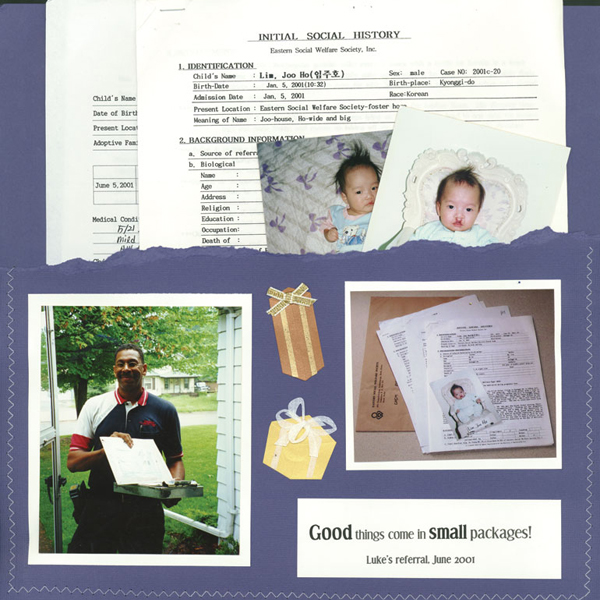Although details of our son Quin’s early years are sparse, we were lucky to receive hundreds of photos of him, his friends, and his caretakers at the orphanage where he spent his first four years. Unfortunately, when I began an adoption lifebook for Luke, our second son, I didn’t have much to work with: bimonthly medical updates, referral information, and fewer than a dozen photos. It was time to get creative! Whether your child came to you at the age of five hours or five years, from a nearby city or a continent away, here are some ideas to help you get started.
Scrapbook, Lifebook, Baby Book?
Before you get out the scissors and acid-free tape, decide what you’ll be creating. A scrapbook is a collection of photos and other images meant to preserve your family’s memories. Adoption scrapbooks are centered on the child, of course, but often include extended family, friends, and others involved with him or her.
A lifebook is the story of your child’s life, starting at birth, written for him. Because it may include sensitive parts of the story, a lifebook is not meant to be shared outside the immediate family.
Then, many families create a separate book to help young children understand how they joined the family. Christy Shaw, whose daughter was adopted at birth, adapted a store-bought baby book to document the wait as well as her daughter’s early months. As her daughter grows, she plans to add to their family scrapbook and create a special one for her daughter.
Lynn Vennefron and her husband also adopted a daughter at birth. She decided to include only the general outline of her daughter’s story in their family scrapbook. Personal details, photos, and information will go into a special adoption book. “We have come to know and love our daughter’s birth mother, and we respect the difficult decision she made. We want to protect her privacy, while letting our daughter be the first one to hear her own story.”
Like Vennefron, I included our children’s adoption stories in our family scrapbook, but I also created special “kid-proof” books made for little hands. I wrote each boy’s story in simple language, reinforcing truths our boys need to know, and printed it out, two or three sentences and one photo to a page. I slipped color copies of these into plastic page protectors in a three-ring binder. These books are a popular choice for bedtime reading, and my boys can often be found casually flipping through them on their own.
Creative Mementos
You need to know that I will stop at nothing to capture a memory. My husband didn’t believe I would actually take a picture of the FedEx man who delivered our referral, but there I was, ready and waiting with my camera, when he rang the doorbell. Embarrassing? Slightly. Worth it? Absolutely! The point is, if you know you may be without photos of your child’s early life, make up for it by documenting what you can.
Don’t have many photos? Use your imagination to create other mementos. Compose a letter to your child when you receive her referral photo. Describe your first meeting with his birth mother. Write a poem, or copy out quotes about adoption.
Save things that have a special association with your child’s history or your adoption journey, such as a piece of stationery from the hotel where you stayed. Beth O’Malley, author of Lifebooks: Creating a Treasure for the Adopted Child, pressed a flower from her daughter’s birth country. “I actually wanted to bring back some soil,” she laughs, “but I was afraid to go through customs with it.” When we had to make an unexpected trip to Minnesota to meet our son’s incoming flight, we bought a postcard in each state along the way. I’ll use these — along with a map tracing our path — on a page entitled, “Our Journey to You.”
Turn Information into Narration
While medical updates from your adoption agency don’t exactly make exciting reading, read between the lines to see what you can glean. To create a page about our son’s early milestones, we paraphrased the dry language to sound like an entry in a baby book. “At 3 months, you already weigh 5.5 kg. and sleep through the night. You love watching TV and cry when your foster mom leaves the room. You laugh often.” I gathered my son’s measurements from these updates for a page entitled “Growing Like a Weed,” which includes photos of him at various ages.
If you’re really short of information, get creative. Enter your child’s birth date into a This Day in History Web site. Request the front page of the newspaper printed on your child’s birth date in her birth city or country (e.g., The New York Times or China Daily).
Filling in the Blanks
If you don’t have much information about your child’s life before adoption, O’Malley recommends two principles: Let truth be your guide, and keep it age-appropriate. “Use words that suggest possibility,” she advises. Try phrases like “We think that…,” “I wonder if…,” and “We don’t have a photo, but I bet….” Ask your child to draw a picture of what he thinks his birth mom looks like. One creative mom attached a small mirror to a page with the caption: “This is what your birth mom might look like.” (For more talking points, see the “Conversation Starters,” sidebar.)
For children adopted internationally, you can tell part of the story by referencing what generally happens in that culture. You might say, “Foster parents in Korea often carry the babies wherever they go. They hold them all day, then sleep close to them at night.” This allows your child to imagine what her life might have been like, even when you don’t know for sure.
Page Techniques to Stretch Your Photos
Put down those scissors and stickers until you’ve followed Sherry Ramsdell’s example: “I made color copies of the few photos we have of our son’s birth family before I used any of them.” Use self-serve photo kiosks to reduce, enlarge, and retouch any photos you have. Store the originals in a safe place, then you’re ready to go!
Mona Green, the owner of Scrapbook Friends in Adrian, Michigan, tells adoptive parents, “Look through scrapbooking magazines for page layouts that use only one or two photos.” Fill the remaining space with words or embellishments like ribbons, stickers, or paper cutouts. The possibilities are endless!
Remember that less is often more. Pages that focus on a single photo can be striking, especially if the photo is paired with specialty paper or decorative type. One way to use a less-than-perfect photo is to enlarge and copy it in black and white. Then, cover the photo with a sheet of vellum to give the photo a beautiful, fuzzy-on-purpose look that can hide many flaws!
What’s the Point?
Making a lifebook can seem overwhelming. Similarly, browsing through pages of elegant layouts and fancy tools in scrapbooking magazines can be discouraging, but don’t worry. “You don’t have to have a creative bone in your body,” O’Malley reassures. “You can be colorblind and have two left thumbs, and your child’s book will turn out fine. The only mistake is not making one.” Stacey Hamman, the mother of three children adopted from Korea, advises, “Think small. Start where you’re at, and then work backwards.”
Remember, the main purpose of scrapbooking is to preserve your family’s memories. Get creative and have fun. But whether you have one photo or 100, don’t let perfectionism keep you from creating pages that will be cherished for years to come.



